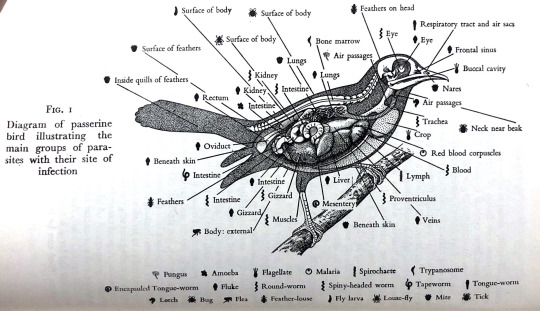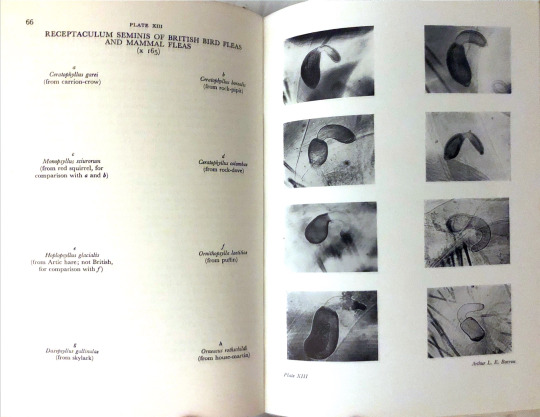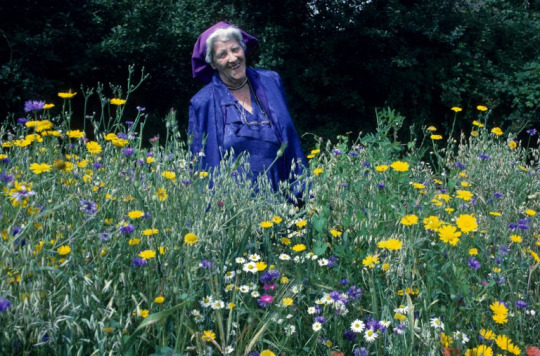#dame miriam rothschild
Explore tagged Tumblr posts
Text
picked up a 1953 copy of Fleas, Flukes, and Cuckoos by (Dame) Miriam Rothschild and Theresa Clay today.

I love parasites so of course upon seeing the title, I couldn't say no. The book is focused on parasites affecting birds, of all types, internal, external, brood parasites... invertebrates and vertebrates... I do love to see so many walks of life contained in a single-topic book that isn't just a nature guide.
(You may notice the "R U" contained in the repeating motifs on the cover. This book was a book from the Readers Union, which was basically a subscription service for books)
one of the biggest draws was the plates and figures:

Fig 1: "Diagram of passerine bird illustrating the main groups of parasites with their site of infection."
I love this one, a charming crash-course on both bird anatomy and the diversity of smaller-size parasites the book covers. it covers these in a good level of detail, too.


for example, it gives comparisons of morphological differences one may observe between different modes of parasite life. The plates on the left show the mouthparts of different invertebrates which feed in different ways. The figure on the right shows the attachment organs of different intestinal worms, showing the variety of "anchors" these worms use to avoid being washed out of a host's intestines.
That's quite broad. It goes deeper. For many invertebrate species, the only way to identify one species from another is by observing the shape of its genitals under high magnification... and so they provide:

I'll make an effort to go through and snatch up more of these plates and figures, some of them are beautiful.
it is not a purely anatomical text. There is a good amount of discussion of the ecology of parasites, including multi-host life cycles (which are pretty common to see).

Here we have the life cycle of Cryptocotyle lingua, which seems to be lacking in online presence; the second host of inshore fish does make it a parasite of interest to fish farmers, which is apparent when browsing papers on Cryptocotyle flukes. if you know more about these guys, please add on!!
Of course not all parasites are invertebrates. the book has plenty on vertebrate parasites, such as skuas, and of course the beloved cuckoo mentioned in the title.

I quite like the inclusion of the skua here since kleptoparasites need some time in the spotlight. Cuckoos are amazing, they deserve a post of their own.
With old biology books, though, I tend to have reservations about the actual biology facts provided within. some fields of biology, e.g., palaeontology, are so fast moving that something that was the new trendy hypothesis is old within a few weeks. Usually I get these books for the plates, and for the history, namely, the comparison of what the authors knew and what we now know.
The then-now comparison that struck me immediately was in the first paragraph of the preface:
"An object of the New Naturalist series is ... the encouragement of unusual and original developments of [natural history's] forgotten or neglected facets. One such facet is the study of parasites, a study all too long regarded as curiosity about mere curiousness, or as excursions into backwaters. Some popular books that have been written on the subject have stressed the unusual, the mysterious, often the macabre. Few have taken the subject truly seriously."
...I do feel this thinking persists in a lot of circles. Parasites are always weird gross-out animals, or at least, the invertebrate ones are. even people who are animal-lovers or environmentally-conscious tend to be keen to take to the idea of Kill All Ticks, or whatever (this is not the same as not wanting to have ticks on your body). It sucks that this sentiment is so pervasive, but it did also feel like "The Editors" (as they signed the preface) reached across decades of separation to shake my hand and go hey, yeah, that bothers me too! Let's do something about it (write this book).
Oh, and a lot more than write this book, a whole lot more. While Theresa Clay is a subject of scrutiny for her association with a fraudulent scientist, Dame Miriam Rothschild was from a lineage of accomplished parasitologists, as well as being one herself -- one of the most established flea experts of her contemporaries, as well as a lepidopterist with an interest in mimicry. She was a great scientist, and has many other achievements: working at Bletchley Park in WWII with Alan Turing, pressuring the UK govt to accept more German Jewish refugees, personally housing some of said refugees & providing a hospital for wounded soldiers, advocating for gay rights, and funding research into understanding schizophrenia and helping folks w/ it. amazing!!

here she is with her wildflowers, grown at the very same house she housed refugees and treated the wounded. You can order packets of seeds from these wildflowers, proceeds go to research to fight cancer, septic shock, and covid-19. She was a pioneer of wildflower gardens as well, creating the "Farmer's Nightmare" seed mix. yet another gift from her. All of these amazing things amplify the need to read this book in full and more thoroughly record all interesting tidbits.
I wish I could have met her, and asked her about this book, and if there was anything she would add or update, or if there were any fun stories. she seems like a real gem of a scientist and activist.
#miriam rothschild#dame miriam rothschild#jewish scientists#woman scientists#parasites#parasitology#ectoparasites#endoparasites#old books#antique books#biology#zoology#ticks#flukes#fleas#miaow#osedax bookblog
15 notes
·
View notes
Link
A guide to finding obituaries can be found here.
Readers can now access all content that is over one year old. This includes memoirs of distinguished Fellows such as Albert Einstein, Dorothy Hodgkin, Sir Alan Parkes, Alan Turing, Dame Miriam Rothschild and John Bernal.
0 notes